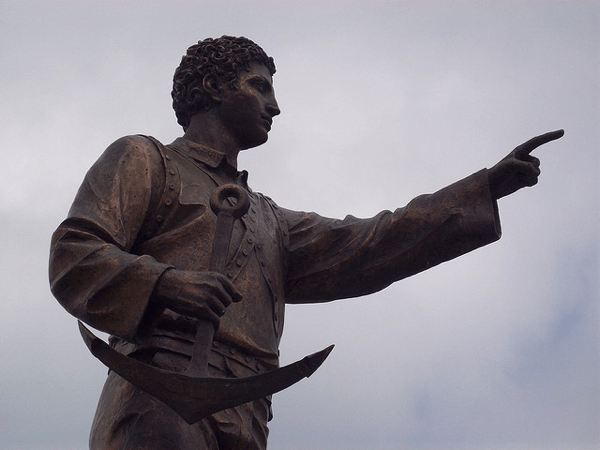The History of Greek Immigration to America
Contents
-
Early start, traveling along the wine-dark sea…
-
First Wave of Immigration (1900-1924)
-
Second Wave of Mass Immigration (1965-1980)
-
Crossing Delancey
-
The isles of Greece/Where grew the arts of war and peace
Early start, traveling along the wine-dark sea…
While mass Greek immigration to the United States begins in the twentieth century, the narrative of Greek arrivals to the U.S. begins much earlier, in 1528 with Don Teodoro Griego landing in Florida. In 1592, on an expedition seeking the northern passage from the Pacific to the Atlantic, Juan de Fuca discovered the US-Canada channel.
Greek workers arrived to New Smyrna Beach, Florida in 1768 with the promise of land. The original colony disbanded by 1777 but many of the colonists moved to neighboring Saint Augustine and set up a successful settlement. New Orleans is the first city in the US where a stable Greek community was established and by 1866 it had the first Greek consulate in the U.S.
The Great Migration from Europe began in the 1880s when cheap manual labor was needed in America and convenient immigration legislation encouraged such migration. Greeks were among the last of the Europeans to immigrate to America during this period.




Previous
Next




First Wave of Mass Immigration (1900-1924)
Greeks were among the last of the Europeans to immigrate to America during the Great Migration, and their numbers are small compared to neighboring nations of Southern Europe, like Italy, for example. Immigration and Naturalization Services data provide documentation that approximately 421,000 Greeks immigrated to the United States between 1890 and 1921.
Their pattern of settlement shows that the majority settled on the East Coast, primarily in Florida and New York, and the industrial Midwest, in Chicago, Detroit, and Pittsburg. Greeks also formed enclaves on the West Coast as they worked in the construction, lumber, and mining industries. However, anti-immigration laws passed in the early twentieth century resulted of four decades of declining Greek immigration to the United States.
The first wave of mass Greek immigration coincides with the first phase of American Industrialization. Therefore, the overwhelming majority of Greeks arrived as a source of cheap labor, unlike previous Hellenic Diasporas in other parts of the world, starting in the 8th Century BCE. In addition to the harsh demands and poor working conditions of manual labor, Greeks faced discrimination. Racial prejudice marginalized and excluded Greeks from certain types of work, from use of public establishments, and harbored negative stereotypes of Greeks. In spite of such hostilities Greek workers were not deterred from participating in labor and political movements for social justice of all immigrants.







Previous
Next
Second Wave of Mass Immigration (1965-1980)
Traditionally, Greek Americans have been concentrated in New York, which has been the preferred place of initial disembarkation and permanent settlement since the first wave of Greek mass immigration to the United States. A unique characteristic of this wave is that Greeks unlike most other European groups immigrated twice on a massive scale to the U.S. in the same century. Greeks inhabited the Astoria section of Queens, New York, during the second wave of mass immigration, and it has been considered the largest Hellenic settlement outside of Greece or Cyprus.
The Greek American community of New York is undergoing a cyclical change, as the original post-1965 immigrants have achieved residential mobility and have moved out of Astoria. They have established satellite communities in nearby semi-suburban areas of Queens. The Greatest number of Greeks in New York reside in the Borough of Queens. Census data show that native born population of the United States reaches 86% while native born Americans of Greek ancestry is slightly higher at 88%. This is an indication of the transformation of the group, supporting that the post-1965 Greeks are beyond the immigrant generation. Greeks are now Americans of an ethnic background.
Greek Americans are represented in all spheres of American society.





Previous
Next
Crossing Delancey
During the European mass immigration period between 1880 and 1924, an influx of nearly twenty million non-Protestant immigrants contributed greatly to the ethnic and religious diversity in the United States.
Historically, in the territory that became the United States, Jewish presence and immigration dates to at least the 1650s. Greek Jews (Romaniotes) did not begin to immigrate to the United States until the early 1900s, following the pattern of their Greek Orthodox compatriots. The immigration of Greek Jews is an integral component of Greek immigration. Their presence in the U.S. diversifies both Greek culture and Jewish faith. They established their first synagogue, Kehila Kenosha Janina, in 1927 in the Lower East Side of Manhattan. They retained their identity, distinct from both Ashkenazi and Sephardic Jews by maintaining the Greek language and conducting religious services in Judeo-Greek.
Romaniote Jews living in New York have a strong attachment to Greece, including visiting Greece. They understand Greek quite well and Greek cuisine and music are embedded in the community. Ethnic attachment is a major indicator of the degree to which members of a group are integrated into the community on three possible levels: culturally, socially, and psychologically. The Romaniote Jews of New York are unique in that they have achieved middle class status through upward social mobility and recent studies document their strong ethnic attachment, embracing Jewish and Greek identities.






Previous
Next
The isles of Greece! The isles of Greece/Where grew the arts of war and peace
In the years surrounding 1821 American involvement in the Greek War of Independence (1821-1829) from the Ottoman Empire was comprised of popular opinion, economic interests, and John Quincy Adams’ application of the Monroe Doctrine emphasizing American isolationism in international affairs. Less than fifty years after the United States declared its independence from Great Britain, the Greek War for Independence was a manifestation of democratic ideals. The sentiment was embodied in the cheer, Washington in 1775 and Ypsilantis in 1821.
The Greek War for Independence resonated around the world and created a global movement of philhellenism, opposite from the conservative stance of their own governments. Similarly in the case of the United States, the populace strongly supported the “Greek Fever” while the government under the pressure of economic interests, never officially recognized the Greek revolutionary government.
The American Congress, with Daniel Webster from Massachusetts, Henry Clay from Kentucky, Sam Houston from Tennessee, Daniel Pope Cook from Illinois, amongst others, invited the government to aid Greece through bills of law. The American Presidents James Monroe and Thomas Jefferson also released statements in support of the Greek rights. American philhellenes adopted children to save them from the war. Among those who stayed in America are: Luca Miltiades Miller, the first Greek American congressman, Evangelos Sophocles, Professor of Greek at Harvard University, and John Zachos, an educational activist for the rights of African Americans and women after the United States Civil War.
Americans who fought in Greece for the cause include: Estwick Evans, Dr. Samuel Gridley Howe, Captain Jonathan P. Miller, George Wilson, and George Jarvis and James Williams (an African American from Baltimore) who both died and are buried in Greece.
Also, American poets influenced by Byronism and the Romantics, published a plethora of poems inspired by the Greek Revolution, among them: James Gates Percival, William Cullen Bryant, Lydia Huntley Sigourney, and James Gordon Brooks “Florio”.




Previous
Next


